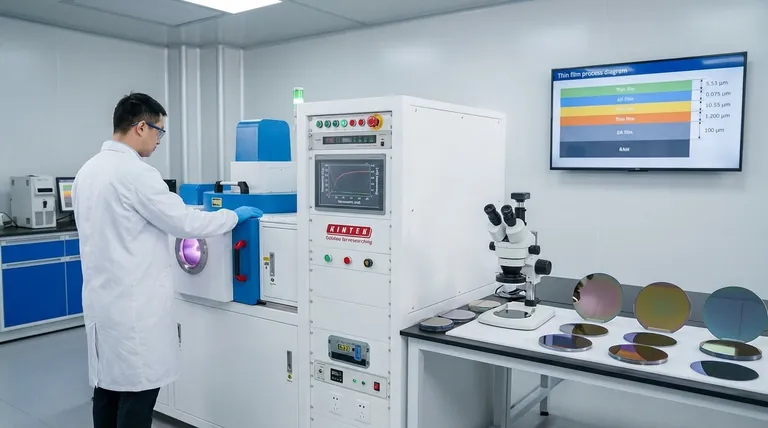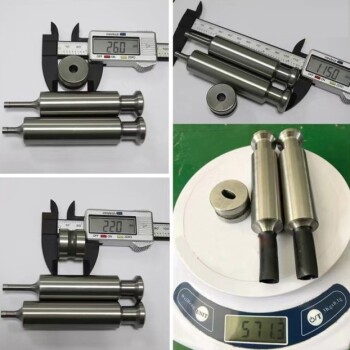In practice, the thickness of a thin film can range from a fraction of a nanometer (a single layer of atoms) to over 100 micrometers. This incredibly broad range means a "thin film" is defined less by a strict number and more by the fact that its properties are dominated by its surface and small dimension, rather than behaving like a bulk material.
The critical takeaway is that a thin film's thickness is not just a measurement; it is the primary design parameter. Changing the thickness, even by a few nanometers, is how you fundamentally control the film's optical, electronic, and mechanical properties to suit a specific application.

What Truly Defines a "Thin Film"?
The term "thin film" covers an enormous scale. Understanding this scale is the first step to appreciating why thickness is so crucial. The definition is more about behavior than absolute measurement.
From Monolayers to Micrometers
A thin film exists on a spectrum. At the lowest end, you have films that are a fraction of a nanometer thick, often referred to as a monolayer. This is literally a single, continuous layer of atoms or molecules.
As you move up in scale, you enter the range of a few nanometers to several hundred nanometers. This is the realm of many advanced optical coatings and semiconductor components.
Finally, you reach the range of one to over 100 micrometers. These thicker films are often used for protective coatings, providing durability and corrosion resistance.
When Properties Diverge from Bulk Material
The defining characteristic of a thin film is that its properties are fundamentally different from the same material in its bulk form. A block of silicon and a 50-nanometer film of silicon behave very differently.
This divergence is because at such a small scale, surface effects and quantum mechanics begin to dominate. The film's thickness becomes a key variable that can be precisely tuned.
How Thickness Dictates Function
Controlling the thickness during the deposition process is the key to engineering a film for a specific purpose. This is a deliberate and precise process.
Controlling Deposition
In common processes like sputtering or evaporation, thickness is controlled by running the process at a constant deposition rate for a specific amount of time.
To achieve a desired thickness, operators simply calculate the required time based on the known rate and stop the process once that time has elapsed.
Impact on Optical Properties
Thickness directly controls how a film interacts with light. An anti-reflection coating on eyeglasses, for example, has its thickness precisely engineered so that light waves reflecting from the top and bottom surfaces cancel each other out.
A few nanometers of aluminum might be semi-transparent, while a 100-nanometer film is a perfectly opaque mirror.
Impact on Electronic and Mechanical Behavior
For electronics, the thickness of a conductive or insulating layer determines properties like resistance and capacitance.
For mechanical applications, a thicker film is generally more durable and scratch-resistant. However, making it too thick can introduce internal stress, causing it to crack or peel away from the surface it's coated on.
Understanding the Trade-offs
Choosing a film thickness is always a balance. There is no single "best" thickness, only the right thickness for a given goal.
Thinner Isn't Always Better
Extremely thin films, while enabling unique quantum or optical effects, can suffer from a lack of durability.
They can also form as disconnected "islands" rather than a continuous, uniform layer if the deposition process is not perfectly controlled, leading to defects like pinholes.
The Limits of "Thick" Films
As a film gets thicker, approaching 100 micrometers and beyond, its properties begin to converge with those of the bulk material.
At this point, the unique surface-dominated effects diminish. It stops behaving like a "thin film" and starts acting more like a simple foil or sheet of material.
Matching Thickness to Your Application
The ideal thickness is entirely dependent on your objective. Consider the primary function you need the film to perform.
- If your primary focus is advanced optics or semiconductors: Your work will be in the angstrom to nanometer range, where light interference and quantum effects are the dominant forces.
- If your primary focus is mechanical protection or corrosion resistance: You will likely operate in the single-digit to tens-of-micrometers range to build a robust and durable barrier.
- If your primary focus is decorative coatings or basic mirrors: A thickness of several tens to a few hundred nanometers is typically sufficient to achieve the desired visual effect.
Ultimately, viewing thickness as your most powerful tool for tuning a film's behavior is the key to successful engineering.
Summary Table:
| Thickness Range | Typical Applications | Key Property Influence |
|---|---|---|
| Fraction of a nm (Monolayer) | Quantum devices, research | Quantum effects, surface chemistry |
| Few nm to 100s of nm | Optical coatings, semiconductors | Light interference, electrical resistance |
| 1 μm to 100+ μm | Protective coatings, durable layers | Mechanical strength, corrosion resistance |
Need to precisely control your thin film's properties? The thickness of your coating is the primary design parameter for its performance. At KINTEK, we specialize in providing the lab equipment and consumables you need to achieve perfect, repeatable thin film deposition for your specific application—whether it's for advanced optics, semiconductor development, or protective coatings. Contact our experts today to discuss how we can support your laboratory's thin film success.
Visual Guide

Related Products
- RF PECVD System Radio Frequency Plasma-Enhanced Chemical Vapor Deposition RF PECVD
- Inclined Rotary Plasma Enhanced Chemical Vapor Deposition PECVD Equipment Tube Furnace Machine
- Chemical Vapor Deposition CVD Equipment System Chamber Slide PECVD Tube Furnace with Liquid Gasifier PECVD Machine
- Microwave Plasma Chemical Vapor Deposition MPCVD Machine System Reactor for Lab and Diamond Growth
- Cylindrical Resonator MPCVD Machine System Reactor for Microwave Plasma Chemical Vapor Deposition and Lab Diamond Growth
People Also Ask
- Why does PECVD commonly use RF power input? For Precise Low-Temperature Thin Film Deposition
- What is an example of PECVD? RF-PECVD for High-Quality Thin Film Deposition
- Why is PECVD environment friendly? Understanding the Eco-Friendly Benefits of Plasma-Enhanced Coating
- How does RF power create plasma? Achieve Stable, High-Density Plasma for Your Applications
- What are the applications of PECVD? Essential for Semiconductors, MEMS, and Solar Cells



















